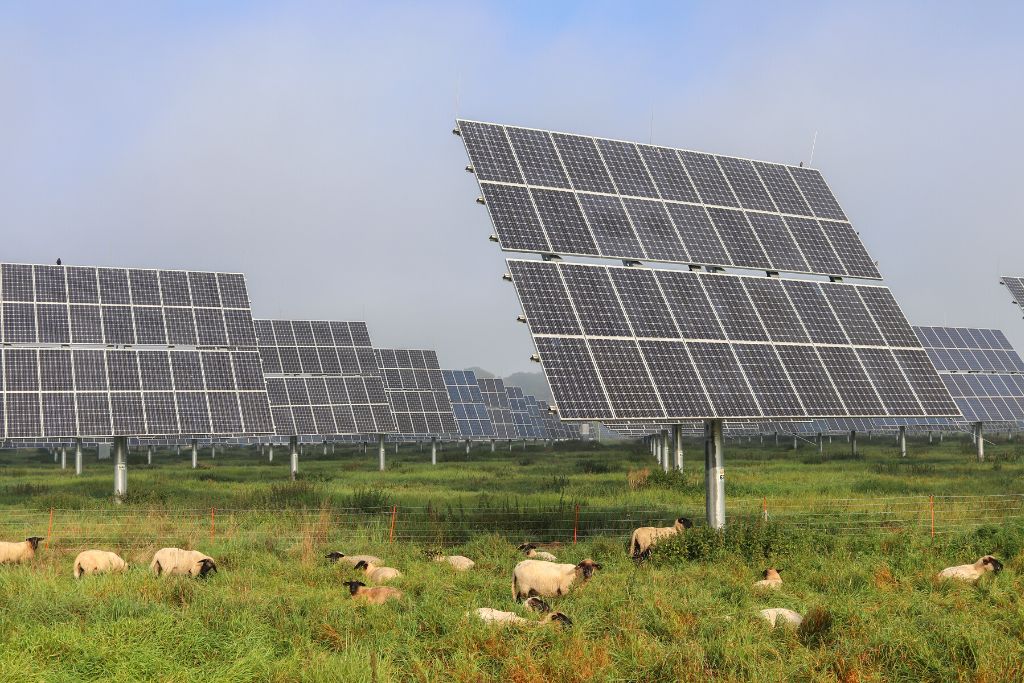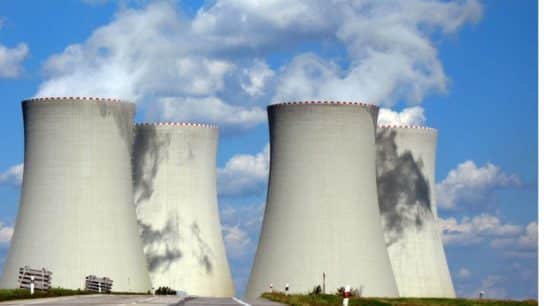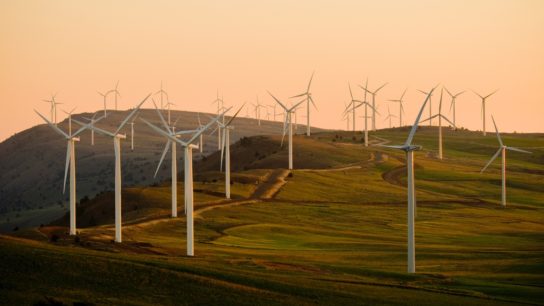A proposal that has been circulated by former UK Prime Minister Liz Truss and the current government would curb the rapid growth of solar projects. Truss, who campaigned on this issue when vying for party leadership earlier this year, is a longstanding critic of the installation of solar panels on farming land. The new Environment Secretary, Ranil Jayawardena, argues that this policy is necessary to achieve growth and boost food production. Yet, landowners across the country are calling for the government to scrap the plan. We take a look at why the UK wants to ban solar projects from English farmland and explore alternative solutions.
—
Despite the claims from both former Prime Minister Liz Truss and other Conservative party ministers, ground-mounted solar panels currently occupy just 0.1% of all land in the UK; and even tentative proposals in place to scale up solar panel installation in line with net-zero promises are expected to occupy just 0.3% of all UK land. To put this in perspective, this would be equivalent to just 0.5% of UK agricultural and farmland.
Solar Power In the UK
Between 2010 and 2015, solar power in the UK highly benefited from feed-in-tariffs. A feed-in-tariff (FIT) is a policy instrument designed to support the growth and development of renewable energy, achieved by providing a guaranteed price for power generation. Prices for FITs can often be above-market prices for producers, intended to nurture an under-invested area of the market. As a result of this policy, the UK saw significant growth in the number of utility-scale solar farms.
In 2016, when the policy of FITs was scaled back and the growth in the number of solar farms crashed. The solar market recovered slowly as the technology behind this renewable energy matured and private markets better understood the risks and rewards of investing in it. Deciding how and when to phase out government-backed investment in renewables is a complex task and is often balanced by considerations such as decarbonisation targets, energy security, and the cost of supporting such schemes.
However, current UK government leaders are not debating the consequences of scaling back government support for solar development.
What Does the New UK Policy Propose?
The proposal by the Conservative party bans the development of new solar projects on agricultural land. In the UK, agricultural land is designated under the status of “best and most versatile” (BMV). Under the proposed policy, changes to how these designations are made would increase the amount of land considered under the BMV status. The outcome is this change would be to seriously restrict the areas of land available for solar development.
Who Advanced the New Proposal?
The proposal to ban solar projects on agricultural land has been discussed by climate-sceptic lobbyists and other members of parliament (MPs) for a few months. Conservative MPs have been increasingly speaking out about both the number and the size of new ground-mounted solar projects, often citing concerns that have been raised in local campaigns against solar projects. For instance, the No Solar Desert campaign has been trying to halt the development of a 600-acre solar farm in North Nottinghamshire. And this is despite the fact that the proposed solar farm would provide clean energy to more than 140,000 homes, as the developer of the site, Island Green Power, suggested.
Opposers of the move have often supported their claims by citing their desire to see wildlife and biodiversity prioritised, as well as ensure that enough “productive land” is preserved for agriculture. Similarly, the UK government has cited food security concerns following the Russian invasion of Ukraine and subsequent concerns regarding global wheat production for wanting to halt the development of solar projects on farmlands.
You might also like: How Wheat Shortage Is Sparking a Global Food Crisis
How Much Land Do UK Solar Farms Actually Occupy?
Currently, solar farms in the UK have a combined capacity of around 14 gigawatts (GW). In the government’s energy security strategy published earlier this year, an outline was provided to deal with the UK’s energy crisis and pledges to achieve net-zero targets. Within this strategy, a pledge to increase solar power capacity from 14 GW to 70GW by 2035 was made. For context, a rough estimate is that for every 1 GW, enough energy is generated to power 750,000 homes.
According to studies carried out by Solar Energy UK, 9.6GW of the current capacity in the UK is sourced from ground-mounted solar panels. Additional studies have sought to calculate the amount of land space required for current energy demands. Existing projects take up less than 1 square kilometre per megawatt (MW) of power generated. This means that the land coverage for existing projects totals 230 square kilometres (km2), equivalent to about 0.1% of land in the UK.
While it sounds like a large area of land covered by ground-mounted solar farms, it is important to contextualise these numbers. Data collected and published by the UK government reports that agricultural land covers about 71% of UK land. This is perhaps best demonstrated graphically, in which existing solar farms use less than half of the land currently occupied by golf courses and airports, which cover 1,256 and 493 km2 respectively.

Graphic demonstrating land use patterns in the UK from golf courses, airports, current and future solar projects. Source
Nowadays, food security and food production are very controversial topics in the country. In the past three years, the UK has been heavily impacted by supply disruptions from the pandemic, Brexit, and, most recently, the Russian invasion of Ukraine. Government figures show that Britain imports 46% of its fresh vegetables and 84% of its fresh fruit. Studies have also shown that the UK would be particularly vulnerable to shocks in the Mediterranean, where increasing temperatures as a result of climate change have been disrupting food production. Only by transitioning to renewables can we begin to alleviate food insecurity as a result of climate change, once again making a case for a transition to greener sources of energy.
You might also like: 3 Biggest Threats to Global Food Security
Can We Increase Solar Power Generation and Local Food Production At the Same Time?
The debate set in motion by the Conservative Party presents farming and solar power generation as fundamentally incompatible with each other. An interview with a UK farmer conducted by Carbon Brief highlighted the false dichotomy being presented by the UK government.
A farmer in the UK suggested that the problem for them is not to “produce 10 units of food” or “10 units of energy”, but instead six units of both. By choosing farmland that has low yields and rotating between arable land and grassland, farmers are able to flexibly adapt to situations.

Graphic demonstrating the different types of agrivoltaic configurations (Source)
Moreover, a new option to use land to address both food security problems and the generation of new renewable energy is gaining traction across the world. First advanced in the 1980s, agrivoltaics allows crops to be planted below and on top of ground-mounted photovoltaic panels. According to recent data, Japan is a world leader in developing this technology, with nearly 2,000 agrivoltaic installations across the country.
You might also like: The Advantages and Disadvantages of Agrivoltaics
And that’s not the only benefit of combining agriculture and photovoltaics. In 2019, a study demonstrated that energy production potential is actually increased in areas of croplands because of the cooling effect of crops’ evapotranspiration – a process in which water moves from the surface of the air and into the atmosphere.
The buy-in from farmers for agrivoltaics is of enormous importance. As has been noted across many solutions developed to alleviate the impacts of climate change, stakeholder buy-in and public endorsement of such technologies can increase wide-scale deployment and lower costs.
Instead, by proposing to ban solar panels from farming land, Conservatives are presenting a false dichotomy: renewables or food security. In failing to be thoughtful and innovative in their policy solutions, the UK might be missing an opportunity to be at the forefront of the green technology revolution.
Disclaimer: Since this article was written, Liz Truss has resigned and Rishi Sunak was nominated by the Conservative Party to take on the role as Prime Minister of the UK. Given the currently volatility of UK politics, it is difficult to predict the future of this policy. However, in his initial bid for leader of the party in August, Rishi Sunak also campaigned heavily on banning solar projects on farmland. Given the support from other Conservative party members and the new PM, it is likely that some attempt will be made to move forward on this policy.
You might also like: What Are the Advantages and Disadvantages of Solar Energy?














